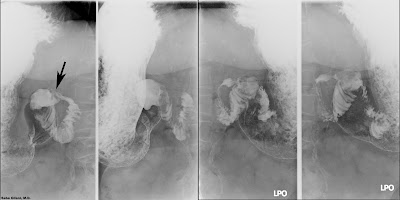Peripheral Cholangiocarcinoma
- malignant tumor arising from interlobular bile ducts
- peripheral enhancement on arterial phase CECT with gradual centripetal fill in
- delayed enhancement is common due to fibrotic regions within mass
- may have dilated bile ducts upstream from the lesion
Confluent Hepatic Fibrosis
- occurs in the setting of cirrhosis
- usually in the medial segment of the left lobe and/or anterior segment of the right lobe
- peripheral wedge shaped regions of low attenuation on CECT that show delayed enhancement
- biliary ductal dilatation not seen
Metastases
- treated adenocarcinoma (usually colorectal, breast) can cause hepatic capsular retraction
- regions of fibrosis (pseudo-cirrhosis) may also be seen
REFERENCES
Fennessy FM, Moretele KJ, Kluckert T, et al. Hepatic capsular retraction in metastatic carcinoma of the breast occurring with increase or decrease in size of subjacent metastasis. AJR Am J Roentgenol 2004;182(3):651-5.
Lee JW, Kim S, Kwack SW, et al. Hepatic capsular and subcapsular pathologic conditions: demonstration with CT and MR imaging. Radiographics 2008;28:1307-23.
Lipson JA, Qayyum A, Avrin DE, et al. CT and MRI of hepatic contour abnormalities. AJR Am J Roentgenol 2005;184(1):75-81.








